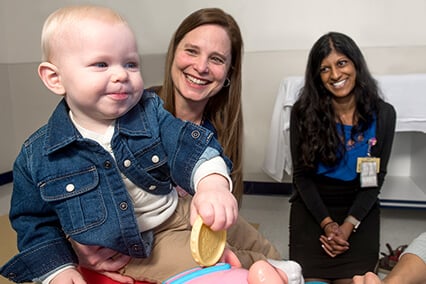Perinatal Stroke: Sadie's Story
To look at 2-year-old Sadie Ewy, you would never know that just before she was born, she had a stroke that affected the right side of her body. That’s why the right-handed “high-five” she gave her pediatric neurologist, Roha Khalid, MD, at a recent check-up was so special.
Only two years earlier, Sadie’s mom, Sara Mitchell, said her pregnancy had gone smoothly, as did Sadie’s delivery on Jan. 30, 2016. But the next morning as she cradled Sadie in her arms while talking to her doctor, Sadie suddenly turned an ashen gray.
“My doctor looked at me and said, ‘Did that baby just go off-color on you?’” Sara recalled. “And I said, ‘Yes. She did.’”
Sara’s doctor immediately put Sadie in her bassinette and wheeled her into the hallway, where she placed oxygen on her, then took her to the hospital’s neonatal intensive care unit for tests.
Fast diagnosis, exceptional care
Four hours later, Sadie had received an electroencephalogram, electrocardiogram, echocardiogram, MRI and a diagnosis—perinatal stroke.
Apparently, sometime just before Sara delivered Sadie, she had had a stroke on the left side of her brain, potentially affecting her speech and right-sided function.
Though the cause of the stroke couldn’t be determined, testing did rule out a heart problem and a clotting disorder seemed unlikely.
“The other common cause of perinatal stroke is a placental abruption,” Sara said. “That might have been the case with Sadie, but we can’t say for sure.”
The episode that occurred as Sara held her daughter was a seizure, and is common in infants who have had a perinatal stroke. During each seizure, Sadie would stop breathing, then turn blue. To control the seizures, Sadie was placed on anti-seizure medications.
“When I heard the diagnosis perinatal stroke, I thought we might be in the NICU for weeks,” Sara said. “But after a couple of days, the medication began to control the seizures well, and Sadie was released from the hospital nine days later.”
A chiropractor by profession, Sara was thrilled to have her infant daughter home, but concerned about the long-term side effects the stroke might have.
“I took it upon myself to get a second opinion and contacted Children’s Mercy. I learned that they had just hired a pediatric neurologist who specializes in stroke,” Sara said. “I would have driven anywhere to have seen Dr. Khalid, but luckily, she had just started here. Sadie’s appointment was nine days later.”
Dr. Khalid confirmed Sadie’s diagnosis and answered Sara’s questions about medications and therapy. She also referred Sadie to her colleague, Mukata Sharma, MD, hematologist, to rule out a clotting disorder, and to an ophthalmologist to check for issues with Sadie’s vision.
About a year after Sadie became Dr. Khalid’s patient, Drs. Khalid, Sharma and Sathya Vadivelu, MD, rehabilitation medicine, led an initiative to launch the Children’s Mercy Comprehensive Stroke Clinic, one of just a handful in the nation focused on pediatric stroke.
The clinic team sees 60 to 100 patients diagnosed with pediatric stroke each year ranging in age from infants, like Sadie, to 18 years old. It streamlines hematology, neurology and rehab services under one umbrella for the best outcomes and the family’s convenience.
Inspired to help other families
For Sara, it’s clear that Sadie has done so well thanks to early diagnosis and treatment, but as a health care provider, the issue has inspired her to help other parents whose children have had strokes, too.
“Many parents don’t know their child has had a stroke until they begin to miss important developmental milestones,” Sara said. But a stroke diagnosis comes with a need for a range of services, such as physical, occupational, speech and gait therapies. And often these services are hard to find.
“We wanted parents in the Midwest to have access to the resources in this community to help children diagnosed with stroke,” Sara said.
So Sara and her friend, Shiloh Little, whose son Jace also had a stroke, started the Children’s Stroke Foundation of the Midwest. The two have put together a notebook and flash drive full of resources for parents. They also have established a website called kidscanhavestrokestoo.com.
Going forward
Sadie is doing so well, her next check-up with Dr. Khalid isn’t for nine months. Going forward, Sara said she and her husband, Greg, will be on the lookout for problems as Sadie reaches developmental milestones. So far, she’s had no problems with her speech. The only tell-tale sign the 2-year-old has had a stroke is some weakness in her right hand, which she’ll continue to work on via physical and occupational therapy.
“Kansas City is so lucky to have Children’s Mercy and the Stroke Clinic here,” Sara added. “I feel like Sadie has gotten the best of the best care since the day she was born. Dr. Khalid has been our pediatric neurologist for the last two years and she is exceptional at what she does. We are beyond blessed to be in her care!”
Pediatric stroke: Ben's story
The Children’s Mercy Comprehensive Stroke Clinic stabilized newborn Ben McKinnon using blood thinners after he had a life-threatening perinatal stroke. Today, the toddler is walking and running, thanks to early intervention.

Pediatric stroke: Talan's story
A 2 ½ years old Talan Turner suffered a devastating stroke. After months of physical, occupational and speech therapy at Children’s Mercy, Talan is walking, running and chasing the family dog.
